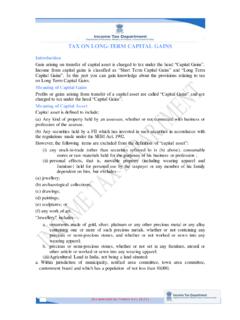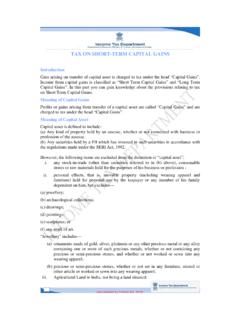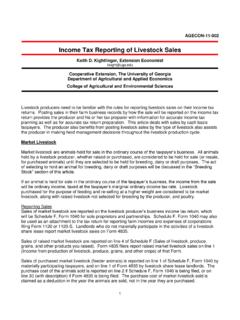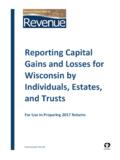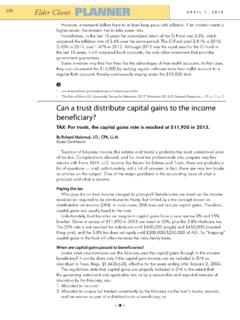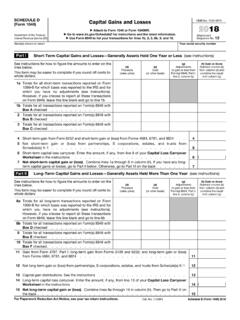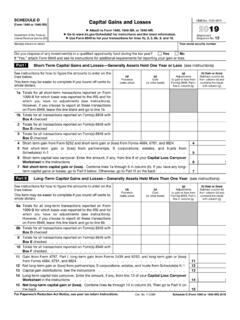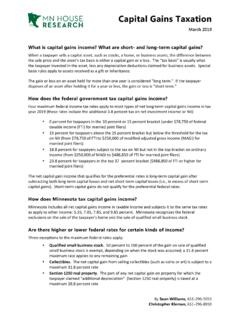Transcription of File 20 Other Forms You May Have To What's ... - IRS tax forms
1 Userid: CPMS chema: instrxLeadpct: 100%Pt. size: Draft Ok to PrintAH XSL/XMLF ileid: .. /I1041 SCHD/2017/A/XML/Cycle06/source(Init. & Date) _____Page 1 of 11 13:20 - 10-Jan-2018 The type and rule above prints on all proofs including departmental reproduction proofs. MUST be removed before for Schedule D ( form 1041) capital Gains and LossesDepartment of the TreasuryInternal Revenue ServiceSection references are to the Internal Revenue Code unless otherwise DevelopmentsFor the latest information about developments related to Schedule D and its instructions, such as legislation enacted after they were published, go to 's NewAt the time these instructions went to print, the ability to roll over the gain from the sale of qualified empowerment zone assets for sales made after 2016 had expired.
2 To find out if legislation extended the ability to roll over gain , go to gains and qualified divi-dends. For tax year 2017, the 20% maximum capital gain rate applies to estates and trusts with income above $12,500. The 0% and 15% rates continue to apply to certain threshold amounts. The 0% rate applies up to $2,550. The 15% rate applies to amounts over $2,550 and up to $12, 8971. form 8971, Information Regarding Beneficiaries Acquiring Property From a Decedent, along with its Schedule A, is used to comply with the filing requirements regarding consistent basis reporting between an estate and a person acquiring property from an more information, see Consistent basis reporting between estate and person acquiring property from a decedent, 1041 E-filing.
3 When e-filing form 1041, use either form 8453-FE, Estate or Trust Declaration for an IRS e-File Return, or form 8879-F, IRS e-file Signature Authorization for form 1041. If form 1041 is e-filed, then any Schedule D ( form 1041) and form 8949 that are part of the return must also be !General InstructionsAny reference in these instructions to you means the fiduciary of the estate or of ScheduleThese instructions explain how to complete Schedule D ( form 1041). Complete form 8949 before you complete line 1b, 2, 3, 8b, 9, or 10 of Schedule Schedule D to report the overall capital gains and losses from transactions reported on form transactions that the estate or trust doesn't have to report on form from Part I of form 4797, Sales of Business gain or loss from form 4684, Casualties and gain from form 6252, Installment Sale gain or loss from form 6781, Gains and Losses From Section 1256 Contracts and gain or loss from form 8824.
4 Like-Kind long -term capital gains from form gain or loss from partnerships, S corporations, or Other estates or capital loss carryover from 2016 to more information, see Pub. 544, Sales and Other Dispositions of Assets; Pub. 551, Basis of Assets; and the Instructions for form Forms You May Have To FileUse form 8949 to report the sale or exchange of a capital asset (defined later) not reported on another form or schedule. See Lines 1a and 8a, later, for more information about when form 8949 is and isn't form 4797 to report the sale or exchange property used in a trade or business; and amortizable tangible property used in a trade or business (but see Disposition of Depreciable Property Not Used in Trade or Business in the Instructions for form 4797); , gas, geothermal, or Other mineral property.
5 126 involuntary conversion ( Other than from casualty or theft) of property used in a trade or business and capital assets held more than 1 year for business or profit. But see Disposition of Depreciable Property Not Used in Trade or Business in the Instructions for form disposition of noncapital assets Other than inventory or property held primarily for sale to customers in the ordinary course of a trade or loss on the sale, exchange, or worthlessness of small business investment company (section 1242) loss on the sale, exchange, or worthlessness of small business (section 1244)
6 form 4684 to report involuntary conversions of property due to casualty or form 6781 to report gains and losses from section 1256 contracts and form 8824 if the estate or trust made one or more like-kind exchanges. A like-kind exchange occurs when the estate or trust exchanges business or investment property for property of a like form 8971 (including Schedule(s) A) to report basis between an estate and a person acquiring property from a 10, 2018 Cat. No. 11378 RPage 2 of 11 Fileid: .. /I1041 SCHD/2017/A/XML/Cycle06/source13:20 - 10-Jan-2018 The type and rule above prints on all proofs including departmental reproduction proofs.
7 MUST be removed before Rules for Determining Basis of Estate and Trust PropertyBasis of trust property. Generally, the basis of property acquired by gift is the same as its basis in the hands of the donor. However, if the FMV of the property at the time it was transferred to the trust is less than the transferor's basis, then the FMV is used to determine any loss upon the property was transferred to the trust after 1976, and a gift tax was paid under Chapter 12, then increase the donor's basis as follows:Multiply the amount of the gift tax paid by a fraction, the numerator of which is the net appreciation in value of the gift (defined below), and the denominator of which is the amount of the gift.
8 For this purpose, the net appreciation in value of the gift is the amount by which the FMV of the gift exceeds the donor's adjusted of decedent's estate property. Generally, the basis of property acquired by a decedent's estate is the FMV of the property at the date of the decedent's death, or the alternate valuation date if the executor elected to use an alternate valuation under section Pub. 551 and the Instructions for form 706 for a discussion of the valuation of qualified real property under section basis reporting between estate and person acquiring proper-ty from a decedent.
9 Section 2004 of Public Law 114-41 has two major An executor of an estate (or Other person) required to file an estate tax return after July 31, 2015, must provide a form 8971 with attached Schedules A to the IRS, and a copy of the beneficiary s Schedule A to each beneficiary who receives or is to receive property from the estate. The Schedule A must show the final estate tax value of the property received or to be received by the beneficiary. An executor (or Other person) who files an estate tax return only to make an election regarding the generation-skipping transfer tax or portability of the deceased spousal unused exclusion (DSUE)
10 May not be required to provide form 8971 and Schedule If Part 2, column C of the Schedule A received by the beneficiary indicates that the property increases the estate tax liability, the beneficiary must use a basis consistent with the final estate tax value of the property to determine the beneficiary s basis in that property. Calculate a basis consistent with the final estate tax value by starting with the reported value and then making any allowed more information, see the Instructions for form 8971 and Schedule A and Column (e) Cost or Other Basis in the Instructions for form of property acquired from a decedent who died in 2010.










